Andyʼs working notes
About these notesSelf-Therapy - Earley
Text on applying Internal family systems to oneself.
Exercises
p21
Think about two of your protectors. For each one, write out answers to the following questions:
- What is its role in helping you manage your life and interact with the world?
- How does it relate to other people?
- How does it protect you from pain?
- What is its positive intent for you?
- What is it trying to protect you from?
p25
Think about two of your exiles. For each one, please write out the answers to the following questions:
- What emotions does it feel?
- What pain does it carry?
- What is it afraid of?
- What negative beliefs does it have?
- What situation or relationship is it stuck in from childhood?
- What current situations tend to trigger it?
- What protectors come up when that happens?
p55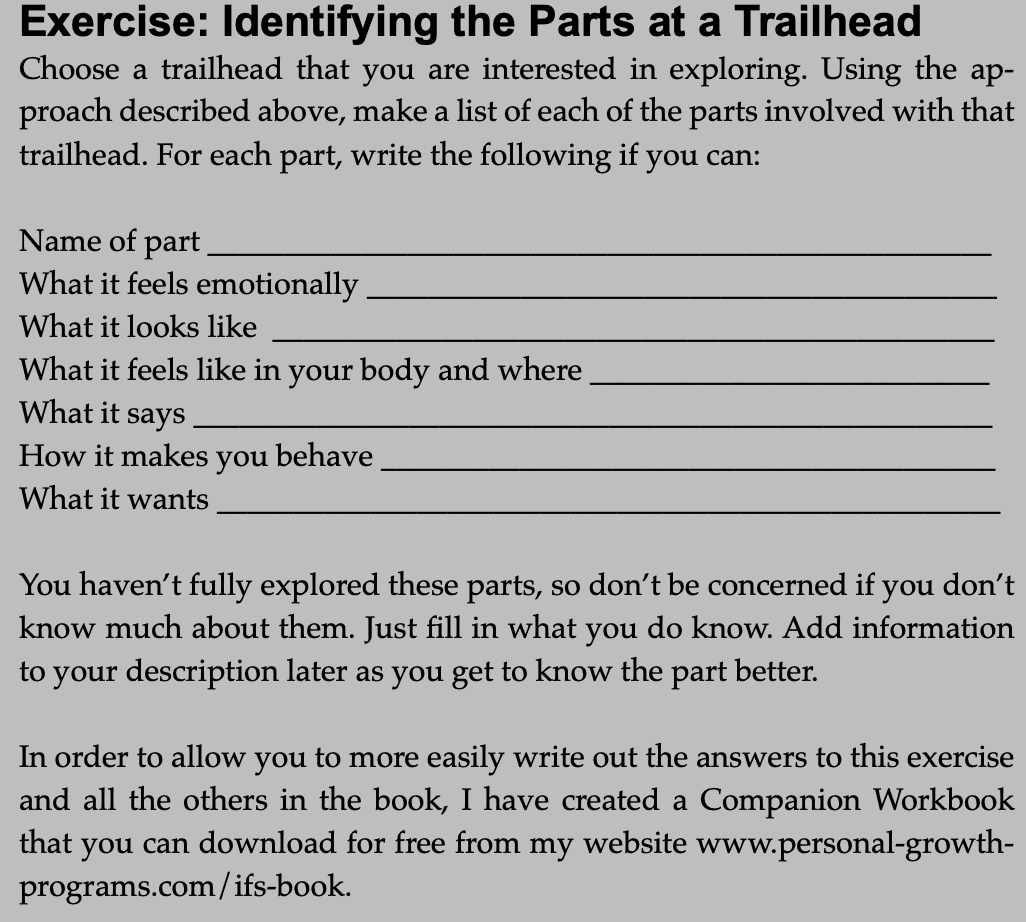
p62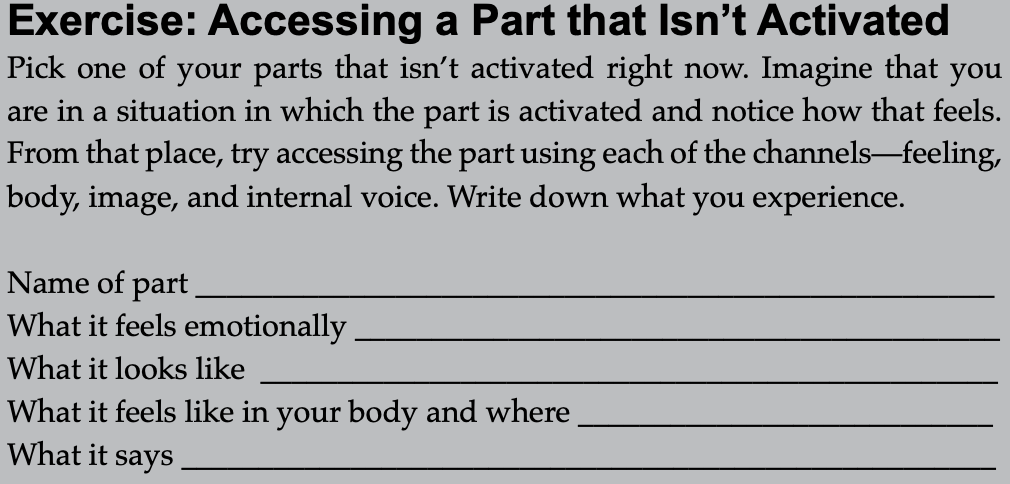
p65

p67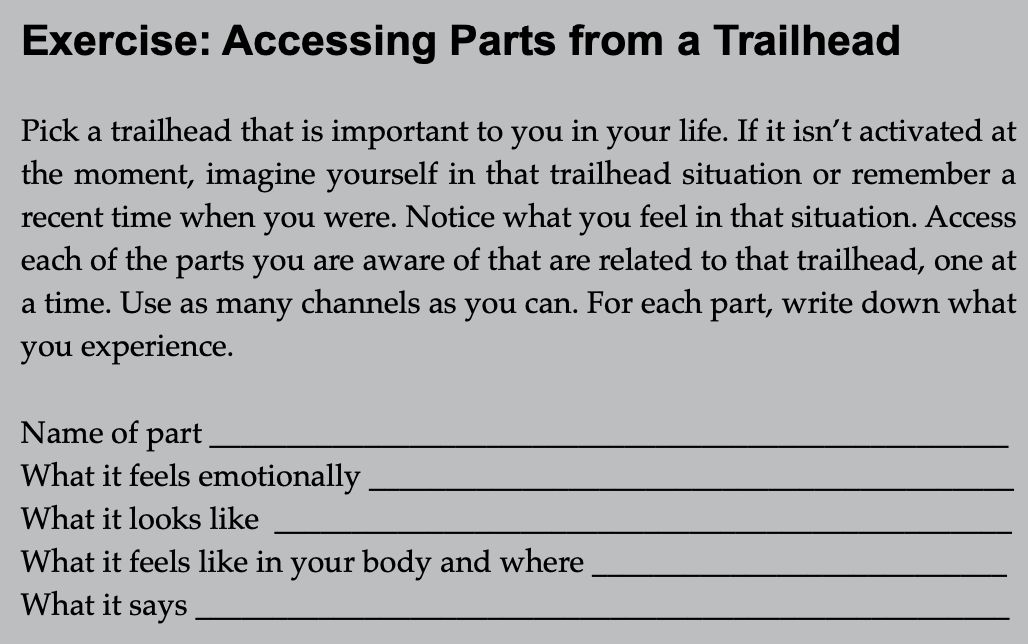
p69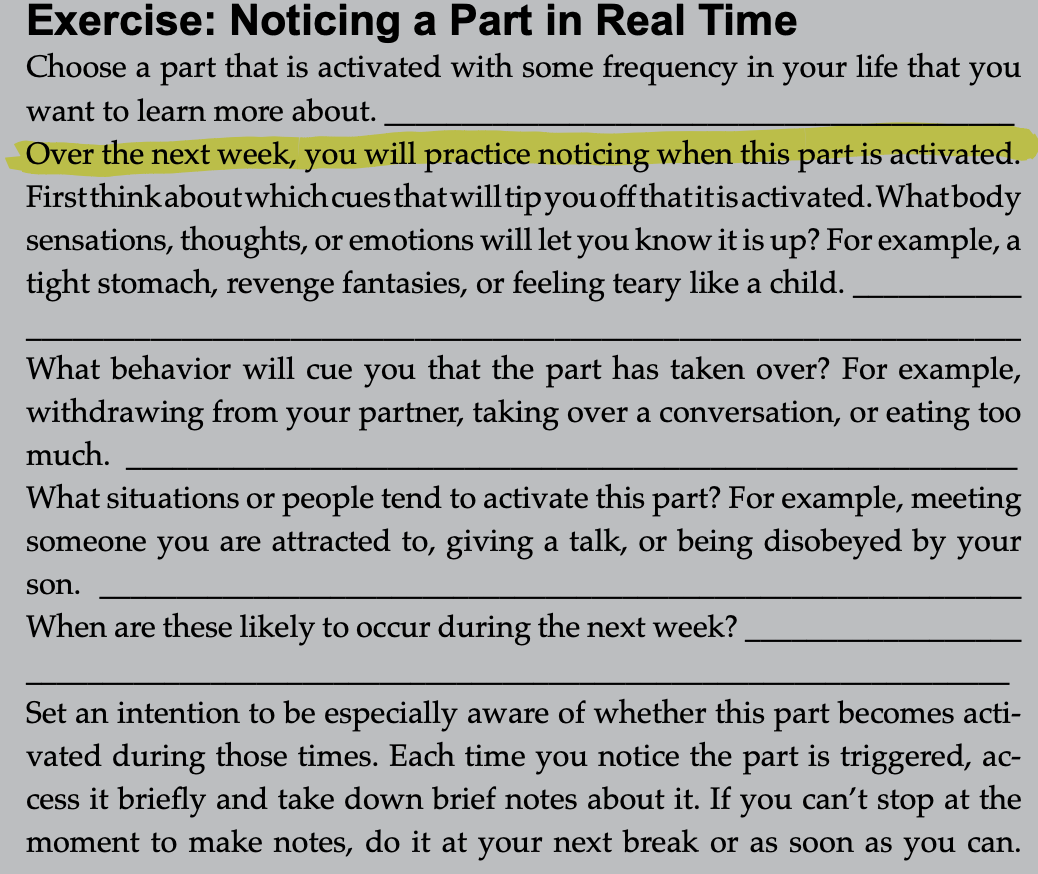
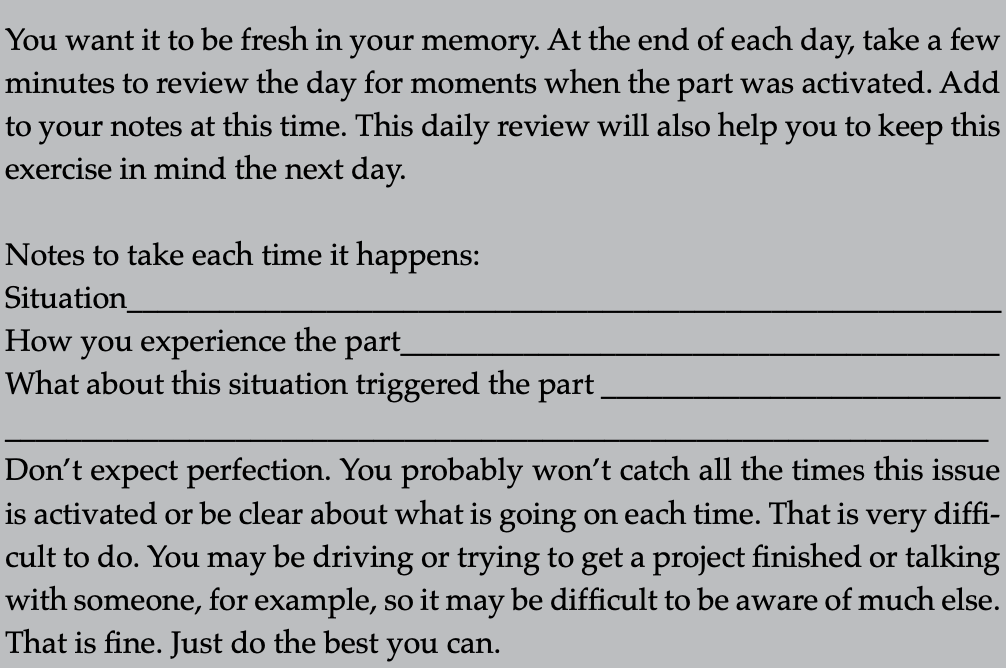
p86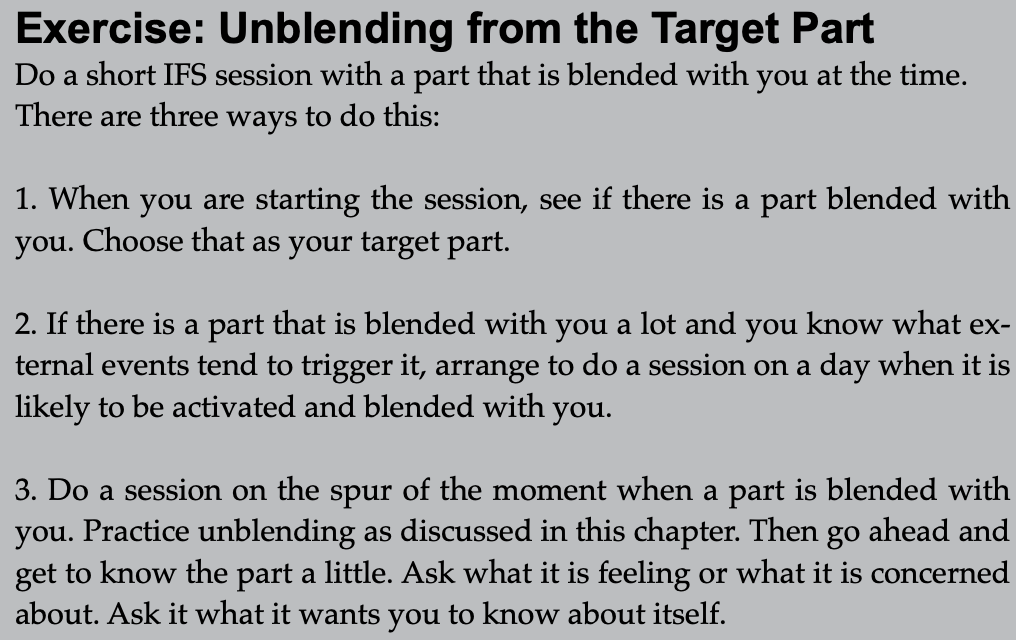
p88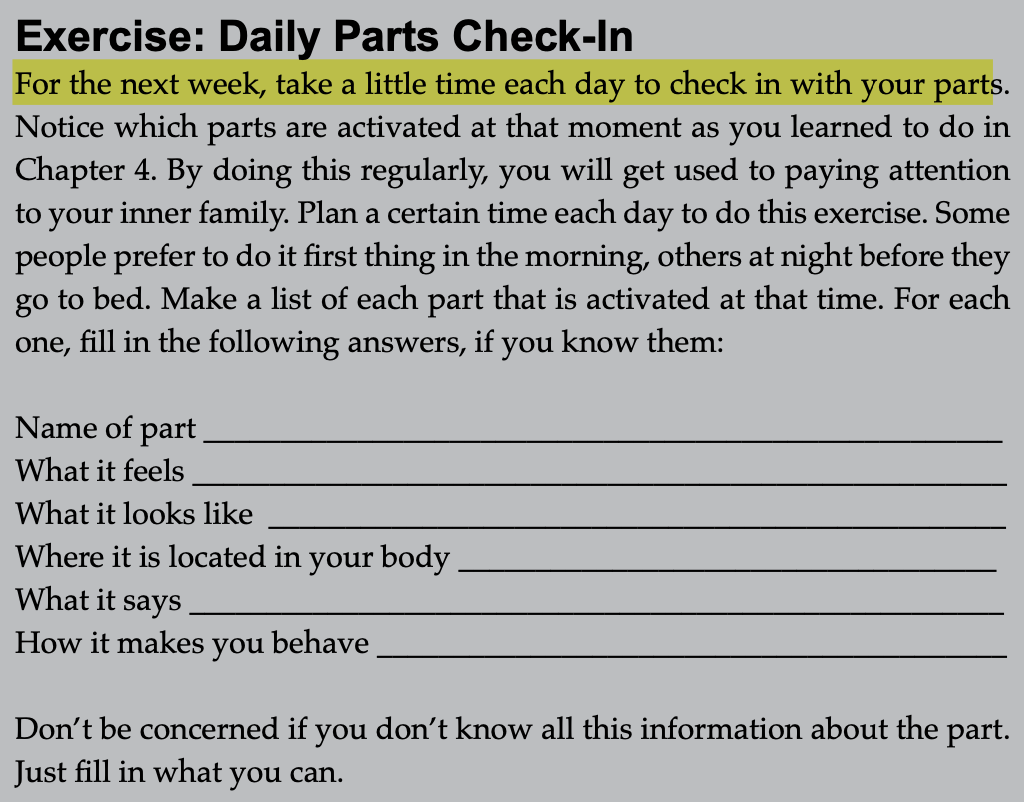
p106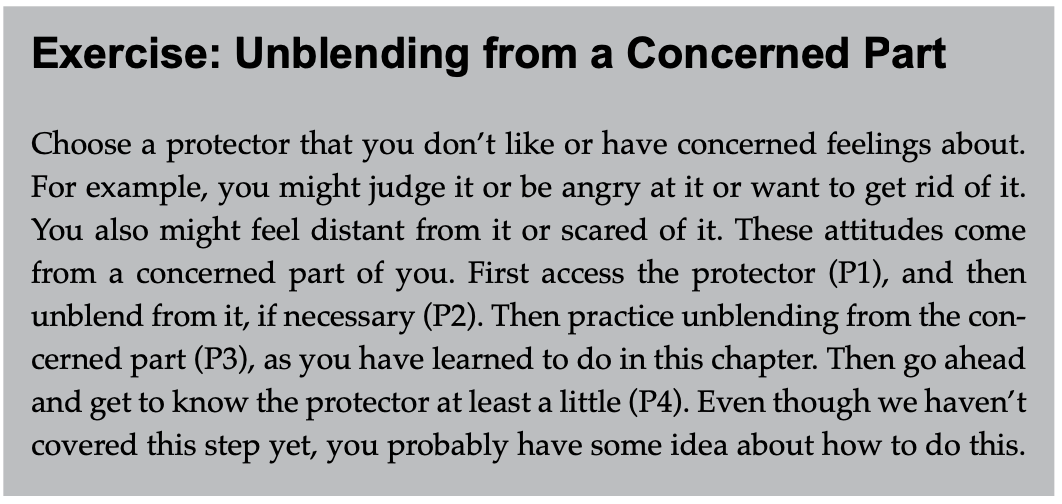
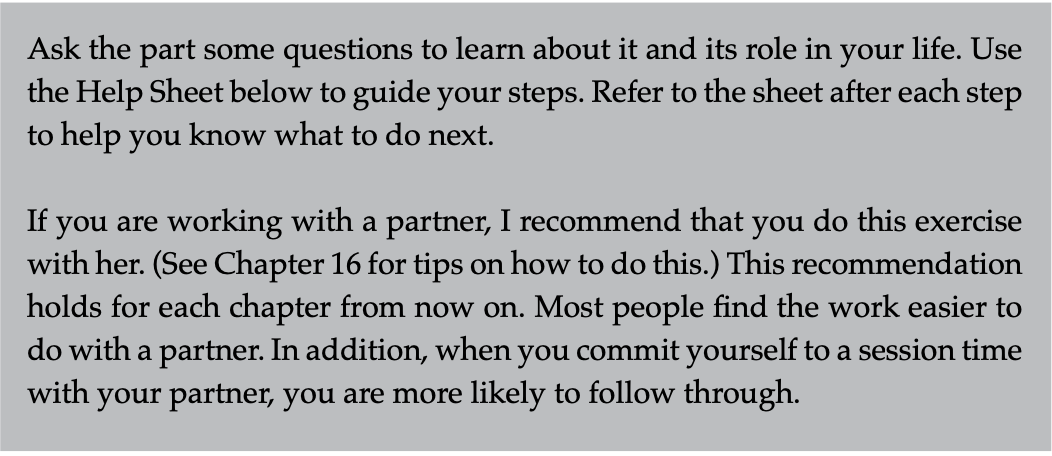
p109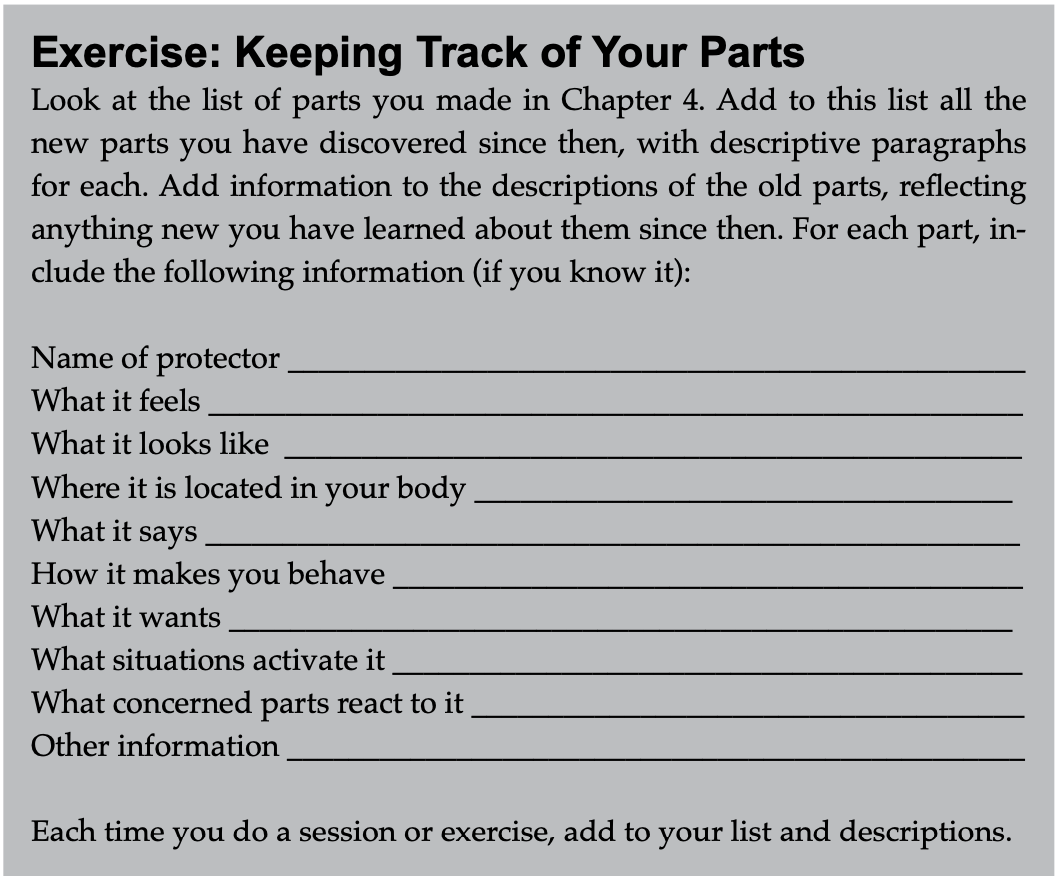
p125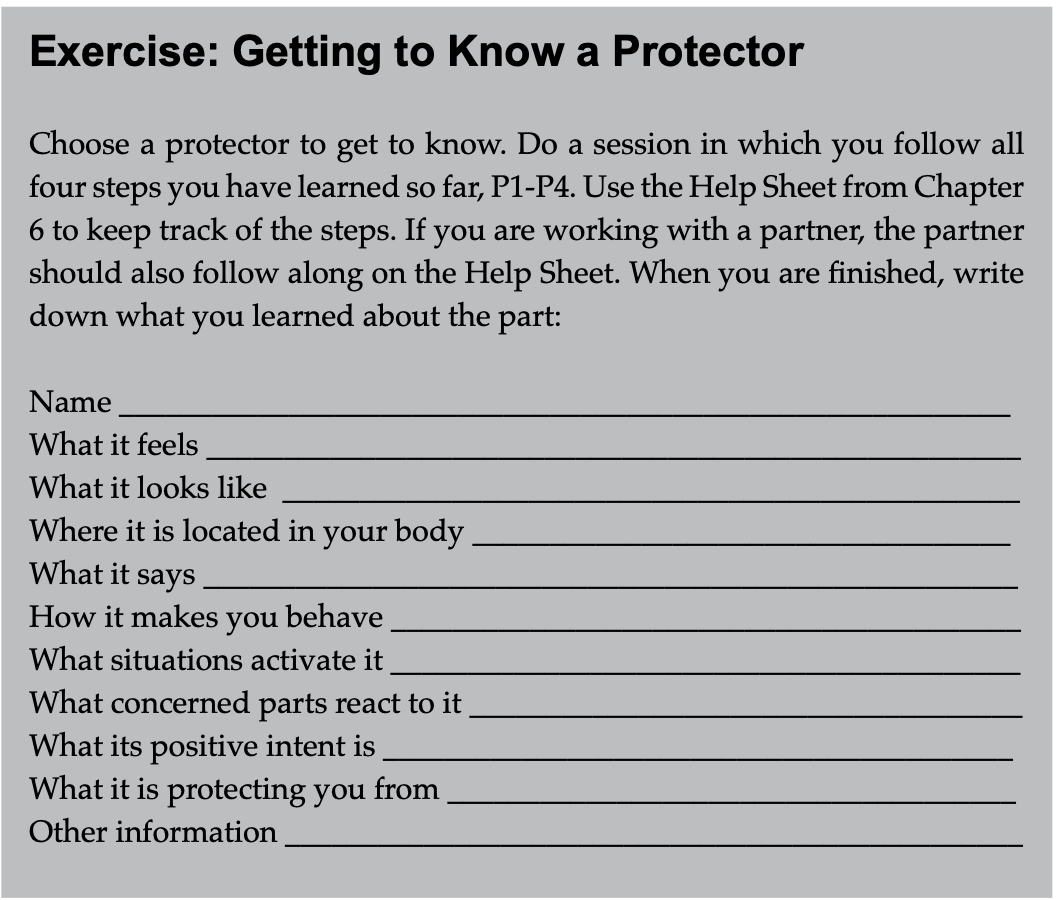
p128
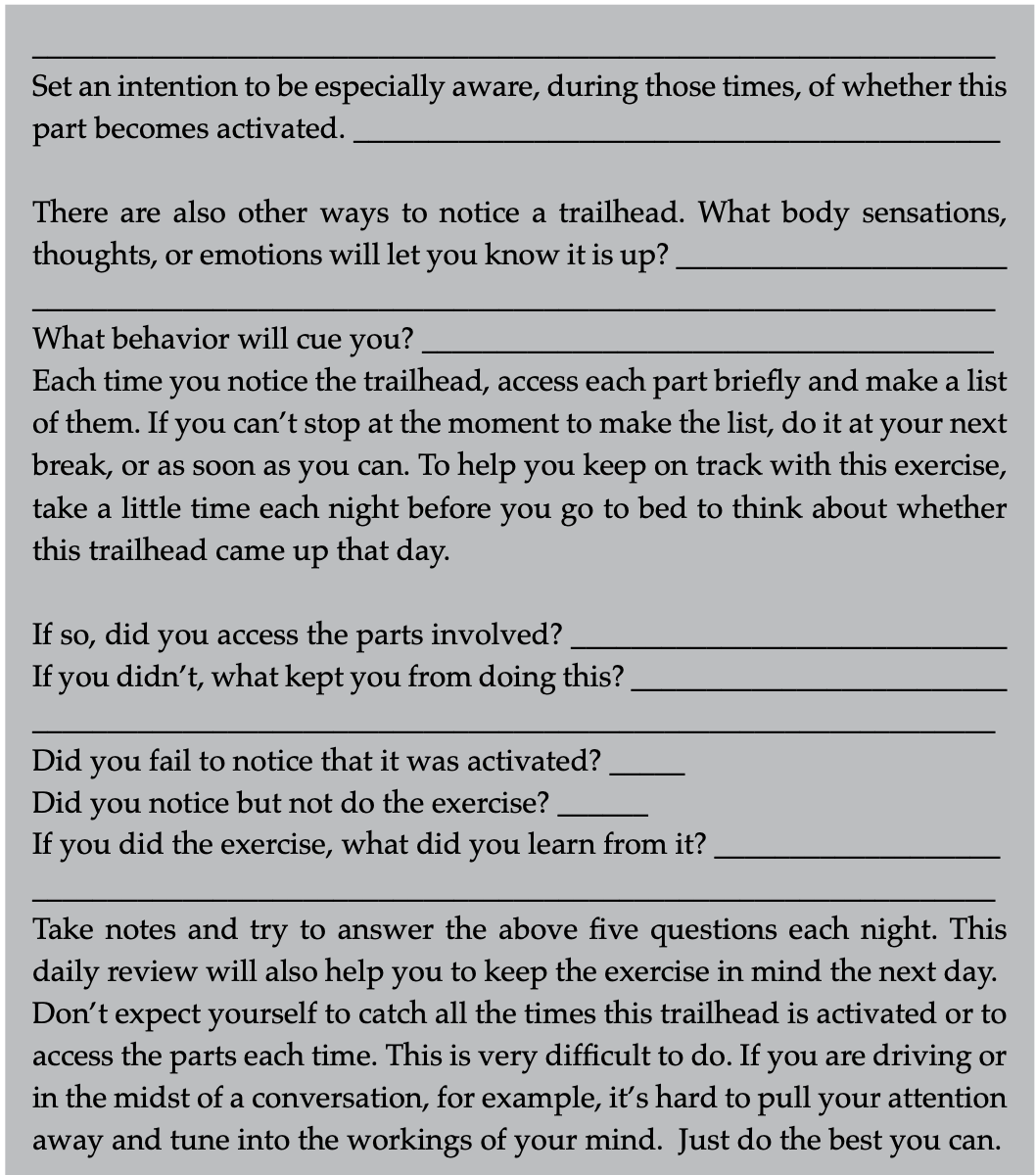
p141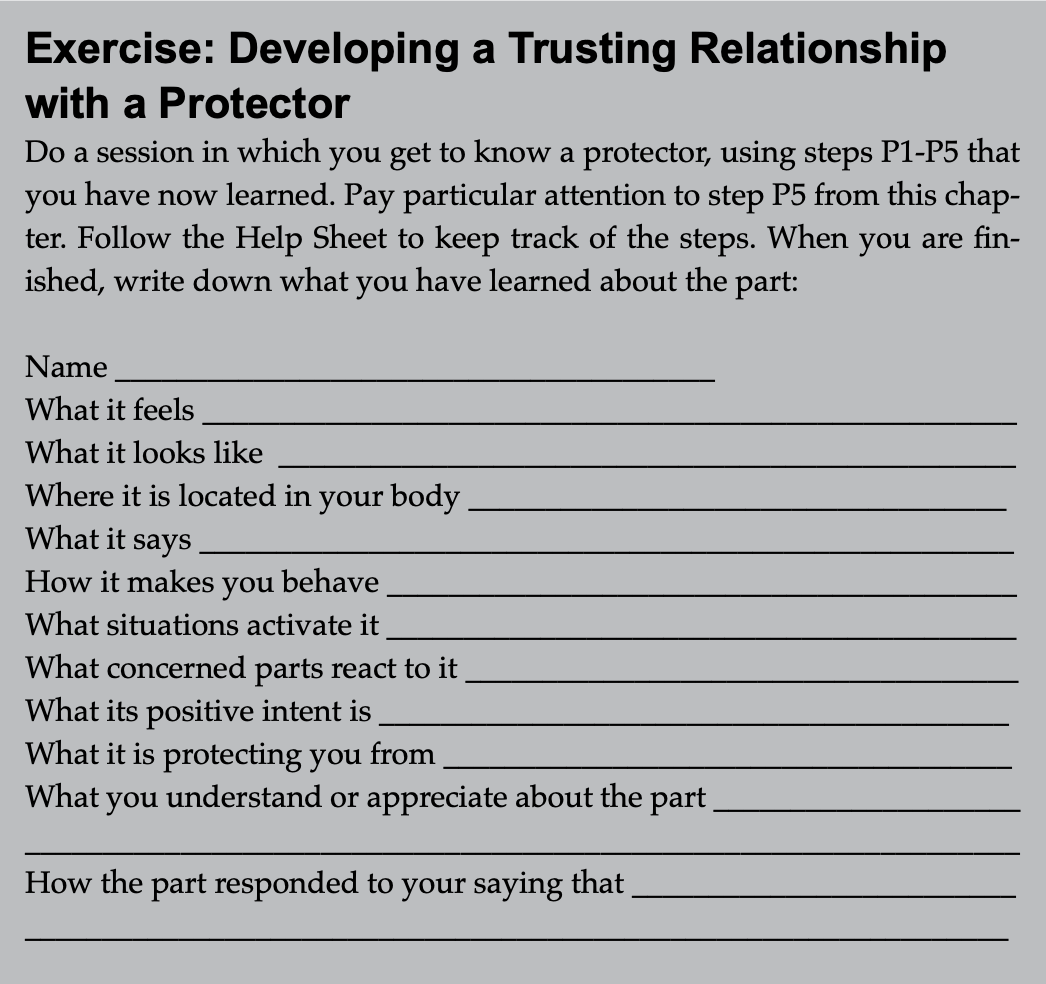
p153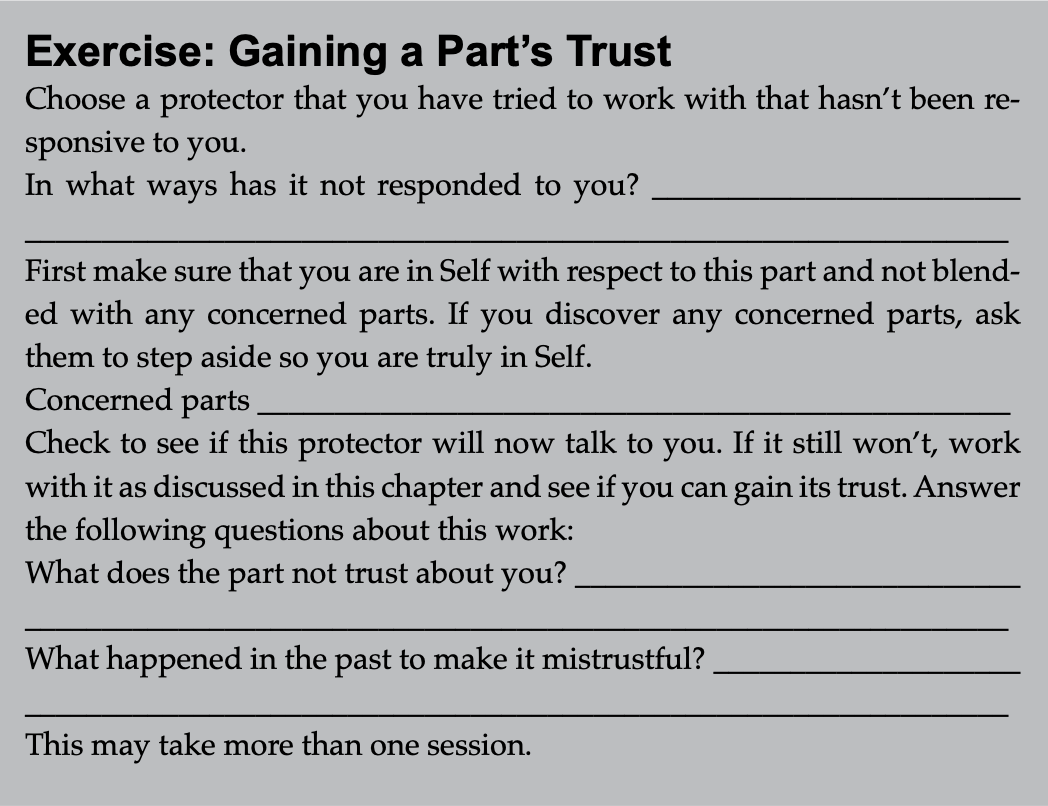
p154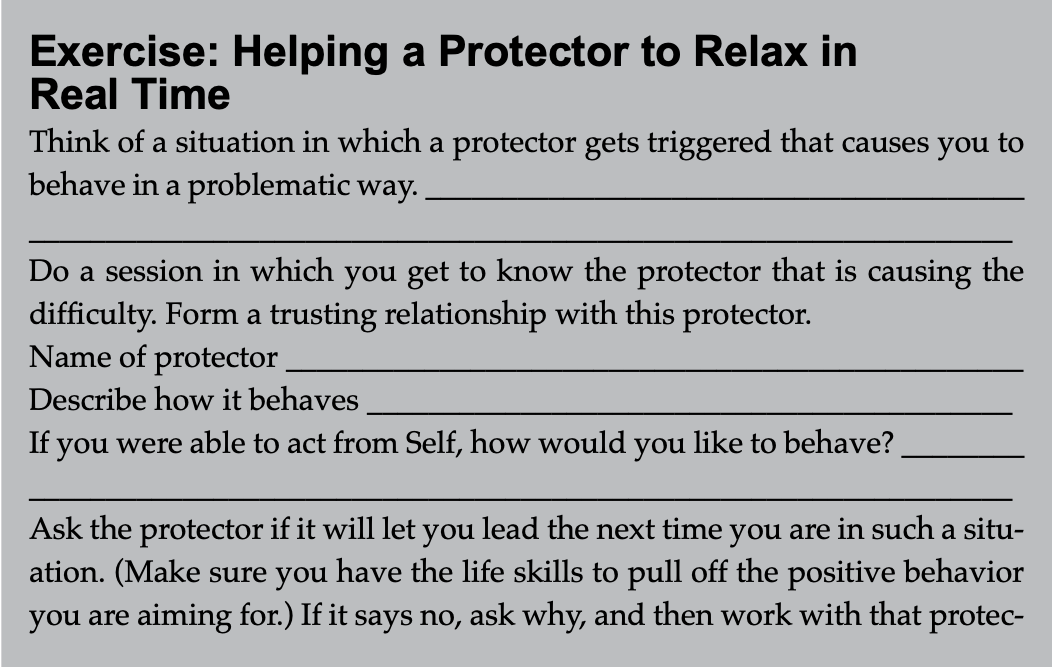

Q. Four qualities of Self?
A. connected; curious; compassionate; calm
Q. What’s meant by the notion that the Self is “connected”?
A. It wants to be close to other people and in harmony; likewise with your parts.
Q. What’s meant by the notion that the Self is “compassionate” relative to your parts?
A. You care about the pain of your exiles; you feel sympathy and concern for the labors and interests of your protectors.
The five steps of getting to know a protector: {accessing a part}, {unblending target part}, {unblending concerned part}, {discovering a protector’s role}, {developing a trusting relationship with a protector}.
Ch 4
Q. How to access a part, in general?
A. Close your eyes, make contact through feelings, sensations, images, internal voices.
Q. How to access a part when it is not activated?
A. e.g. remember a recent time when it was activated, put yourself in that situation
Q. How to begin from a trailhead when you aren’t sure what part to work with?
A. Check inside and use the sensations to access a part; ask it to step aside, then repeat
Ch 5
Q. What’s the next step after accessing a target part?
A. Unblending from it if necessary: check how you feel towards it to see if you’re charged with its emotions.
Q. What is the “seat of consciousness”?
A. The locus that determines which part is in charge of our psyche at the moment.
Q. What must happen, in terms of the seat of consciousness, before we can work with a part?
A. We must ensure that the Self is sitting the seat of consciousness.
Q. What do we mean when we say that a part has “blended” with the Self?
A. We identify with that part; it’s has pushed Self into the background; we’re lost in its feelings.
Q. What are the two most common ways we (naively) relate to difficult parts?
A. We’re blended with them or we feel judgment, anger, or fear towards them.
Q. When we find ourselves wishing a part would go away, what’s happening from IFS’s perspective?
A. We’re blended with another part which is judging that part; we’re not in Self.
Q. How to check for blending with a part?
A. Ask yourself what you feel towards the part. If you’re blended with it, it will be hard to answer that question.
Q. How can your use of pronouns suggest when blending is happening?
A. If you start speaking as the part rather than reporting in third person, you’re probably blended.
Q. How to unblend from a target part?
A. Explain that you want to get to know it; you’re asking it to separate so that you can relate to it, not so that you can push it away.
Q. Strategies for when a target part won’t separate?
A. Ask what it’s afraid of and reassure; explain the value of separating.
Ch 6
Q. What’s the next step after ensuring we’re not blended with the target part?
A. Ensuring that we’re not blended with a concerned part.
{concerned} part: a part which {is worried about problems another part will cause}
Q. What kinds of emotions do concerned parts tend to feel?
A. e.g. anger, fear, judgment
Q. How can you check to see if you’re blended with a concerned part?
A. Check how you feel towards a target part; look for anger, fear, judgment.
Q. What category of parts do concerned parts belong to?
A. Protectors.
Q. How to unblend from a concerned part?
A. Ask it about its worries, listen respectively, express sympathy. Then ask it to step aside so you can get to know the target part from an open place.
Q. What’s the critical verb we use to get a part to step aside?
A. We ask—we don’t push it aside or make it step aside.
Q. Three strategies when a concerned part won’t step aside?
A. Explain value of stepping aside; ask what it’s afraid of and reassure; make the concerned part the target part.
Q. What’s the next step when a concerned part agrees to step aside?
A. Check again how you feel towards the target part.
Ch 7
Q. What’s the next step after ensuring that we’re not blended with a concerned part?
A. Discovering a protector’s role.
Q. How does the way IFS works with a part differ from intellectual/analytical traditions?
A. It puts you in direct contact with the part to give you a better understanding of the part, which in principle will help you heal it more effectively.
Q. How does the way IFS works with a part differ from forms of therapy which ask you to become a target part?
A. IFS avoids blending of this kind on the theory that the compassionate Self is important to the healing process.
Q. How does one discover a protector’s role?
A. Ask it questions, e.g. about its feelings, concerns, and desires.
Five basic questions to ask a protector to discover its role: {What do you feel?} {What are you concerned about?} {What is your role and how do you do it?} {What do you hope to accomplish by playing this role?} {What are you afraid would happen if you didn’t play that role?}
(see p112-113 for lots more good questions)
Q. What counterintuitive detail about a part’s intent are you trying to discover as you get to know it?
A. Its positive intent for you.
Q. Most potent question for discovering a part’s positive intent?
A. What are you afraid would happen if you didn’t perform your role?
Q. Two kinds of protection?
A. Internal and external protection.
Q. How does a protector provide external protection?
A. The protector tries to keep the part from being harmed by other people.
Q. What’s meant by internal protection?
A. Protectors keeping you from feeling the emotion an exile carries.
Q. Examples of internal protection?
A. A part which causes dullness or confusion; a distractor; an intellectualizer which numbs emotional pain; a part which focuses on comfort or self-esteem.
Q. Contrast what internal/external protection implies about a protector’s beliefs about an exile.
A. External protection implies care for a vulnerable exile; internal protection implies concern about a exile which might harm you.
Q. How to end an IFS session? (two key steps)
A. Thank the parts for sharing; check for loose ends.
Ch 8
Q. What’s the next step after discovering a protector’s role?
A. Developing a trusting relationship.
Q. When do most protectors develop their protective strategy?
A. In childhood.
A major goal in IFS is for protectors to learn to {trust the Self}.
Q. Why is it important for protectors to learn to trust the Self?
A. So they can relax enough for you to get to know the exile; and after that exile is unburdened, to let go of its protective role.
Q. Earley’s story about his Accomplisher illustrates what key change in relationship one must make with an extreme protector?
A. Appreciating it.
Q. How, specifically, to develop a trusting relationship with a protector?
A. Let it know that you understand and appreciate it; check how it responds.
Q. What commonly explains a lack of response from a protector after expressing appreciation?
A. It may not be aware of you (try asking it to look at you or briefly identifying with it).
Q. Why might a protector refuse to talk to you or show itself to you? (two main reasons)
A. It may be blocked by a concerned part; it may not trust you.
Q. Two key reasons a part may not trust you?
A. Blending with a concerned part, history of betrayal
Q. How to handle a history of betrayal?
A. Sit with a part until it’s willingg to talk, then ask what it doesn’t trust about you, and what happened to make it feel that way.